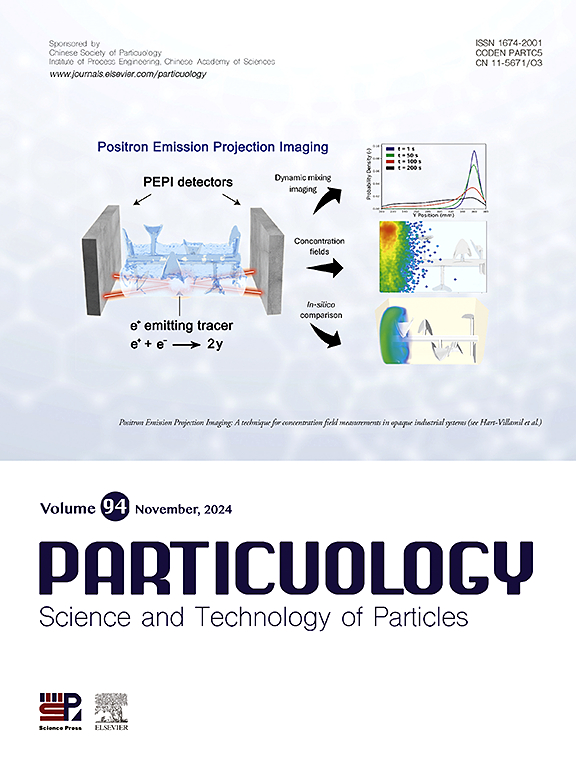4-溴吡唑成核过程中分子组装与成核动力学的关系
IF 4.3
2区 材料科学
Q2 ENGINEERING, CHEMICAL
引用次数: 0
摘要
成核是结晶过程中的关键阶段,决定了结晶产物的属性。由于分子组装过程的复杂性和微观特征,其成核机理尚未完全了解。本研究通过实验和分子模拟研究了4-溴吡唑(BMPZ)在不同溶剂中的分子自组装及其与成核动力学的关系。首先,利用傅里叶变换红外光谱、核磁共振光谱、质谱等方法探索确定了BMPZ分子在溶液中的存在形式;揭示了BMPZ分子的组装行为具有个体特征。然后,采用统计概率分布法确定成核动力学,并从经典成核理论推导出与成核过程相关的参数,进一步与成核动力学联系起来。溶液化学、分子模拟和成核动力学表明BMPZ组装形式可以作为成核的生长单元,成核动力学主要受界面转移过程控制。本文章由计算机程序翻译,如有差异,请以英文原文为准。

Relation between molecular assembly and nucleation kinetics during 4-bromopyrazole nucleation
Nucleation is a critical stage during the crystallization process, determining the attributes of the crystalline products. Due to the complicated and microscopic characteristics of the molecular assembly process, the nucleation mechanism has not yet been fully comprehended. In this study, the molecular self-assembly of 4-bromopyrazole (BMPZ) in various solvents and its relation with nucleation kinetics were investigated by the experiment and molecule simulation. Firstly, Fourier transform infrared spectroscopy, nuclear magnetic resonance spectroscopy, and mass spectroscopy were employed to explore and determine the existed forms of BMPZ molecules in solution. It was unveiled that the BMPZ molecules assembly behavior showed an individual feature. Afterward, the nucleation kinetics was determined by statistical probability distribution method, and the parameters associated with the nucleation process were derived from classical nucleation theory, further associating with the nucleation kinetics. Solution chemistry, molecule simulation, and nucleation kinetics exposed that BMPZ assembly forms could act as the growth unit of the nucleation, and nucleation kinetics was chiefly governed by the interface-transfer process.
求助全文
通过发布文献求助,成功后即可免费获取论文全文。
去求助
来源期刊

Particuology
工程技术-材料科学:综合
CiteScore
6.70
自引率
2.90%
发文量
1730
审稿时长
32 days
期刊介绍:
The word ‘particuology’ was coined to parallel the discipline for the science and technology of particles.
Particuology is an interdisciplinary journal that publishes frontier research articles and critical reviews on the discovery, formulation and engineering of particulate materials, processes and systems. It especially welcomes contributions utilising advanced theoretical, modelling and measurement methods to enable the discovery and creation of new particulate materials, and the manufacturing of functional particulate-based products, such as sensors.
Papers are handled by Thematic Editors who oversee contributions from specific subject fields. These fields are classified into: Particle Synthesis and Modification; Particle Characterization and Measurement; Granular Systems and Bulk Solids Technology; Fluidization and Particle-Fluid Systems; Aerosols; and Applications of Particle Technology.
Key topics concerning the creation and processing of particulates include:
-Modelling and simulation of particle formation, collective behaviour of particles and systems for particle production over a broad spectrum of length scales
-Mining of experimental data for particle synthesis and surface properties to facilitate the creation of new materials and processes
-Particle design and preparation including controlled response and sensing functionalities in formation, delivery systems and biological systems, etc.
-Experimental and computational methods for visualization and analysis of particulate system.
These topics are broadly relevant to the production of materials, pharmaceuticals and food, and to the conversion of energy resources to fuels and protection of the environment.
 求助内容:
求助内容: 应助结果提醒方式:
应助结果提醒方式:


